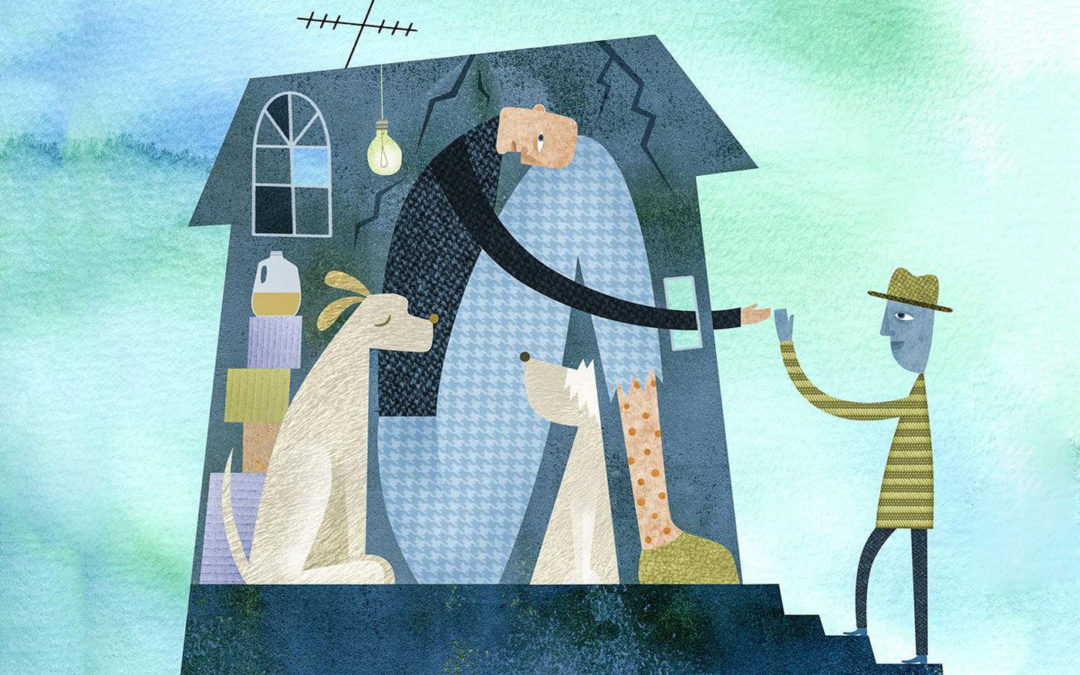The man was living alone with his two dogs, in a remote area outside San Antonio, when someone called the Texas state hotline to report that a supposed friend was financially exploiting him. So the state adult protective services agency sent a caseworker to the man’s home.
She found an 86-year-old Vietnam veteran in a dirty, cluttered house full of empty liquor bottles. His legs swollen by chronic cellulitis, he could barely walk, so he used a scooter.
He missed doctor’s appointments. He had the medications he needed for cellulitis and diabetes, but didn’t take them. Though he had a functioning toilet, he preferred to urinate into plastic gallon jugs. He didn’t clean up after his dogs. He wasn’t eating well.
This behavior pointed to an underrecognized problem called self-neglect. It accounts for more calls to adult protective services agencies nationwide than any other form of elder abuse.
Yet efforts to identify and help older people who neglect themselves often collide with Americans’ emphasis on self-determination.
“If someone has decision-making capacity, do they have the right to live in squalor?” asked Dr. XinQi Dong, a researcher at the Rush Institute for Healthy Aging in Chicago. “As a society, we want to respect autonomy and independence.”
In the Texan’s case, “he wasn’t happy that A.P.S. was there, and he denied that he was being exploited,” said Raymond Kirsch, an agency investigator who became involved. “He also denied that he had a drinking problem.”
Grudgingly, he allowed the agency to set up a thorough housecleaning, to start sending a home care aide and to arrange for Meals on Wheels.
But on a follow-up visit a month later, the caseworker found her client markedly deteriorated. His swollen legs now oozed. He’d become personally filthy and was ranting incoherently. She returned with an ambulance and a doctor who determined that the client lacked the capacity to make medical decisions.
Off he went to a San Antonio hospital, under an emergency court order. The caseworker locked up the house and kenneled the dogs.
We hear much more about other kinds of elder abuse and exploitation. Perhaps it’s easier to respond when someone is being victimized by others than when he is harming himself.
“Family members get fed up and don’t want to get involved,” said Courtney Reynolds, a research analyst at the Benjamin Rose Institute on Aging in Cleveland. “They attribute it to a character issue, like stubbornness, instead of a decline in the person’s ability to manage.”
Self-neglect refers to someone whose behavior threatens her health and safety. In ongoing studies in Chicago, Dr. Dong and his colleagues look for factors like hoarding (of objects or animals), poor personal hygiene and unsanitary conditions.
“People can have sores or lice or pests in the house. They may have medical issues but not be taking medications as prescribed,” added Ms. Reynolds, who has seen self-neglect as a social worker. “There could be piles of garbage, or food stored in a refrigerator that’s not working.”
That’s why self-neglect may go undetected at medical appointments. “If someone comes into my office wearing a clean shirt and pants, I wouldn’t know they’re hoarding at home,” said Dr. Dong, a geriatrician. “You have to observe their living environment.”
In the Chicago studies, involving more than 4,600 South Side residents over age 65, researchers who conducted in-home interviews found self-neglect unnervingly common.
It occurred in 9 to 10 percent of men and 7.5 to 8.5 percent of women, depending on age. Because some residents refused access to their homes, “it wouldn’t surprise me if the prevalence were higher,” Dr. Dong said.
Neglect was more common among those with poor health and cognitive impairment. African-Americans and those with lower income and education had far higher rates of self-neglect. (In a separate Chicago study, so did Chinese-Americans.)
Whatever the underlying causes, “it’s incredibly dangerous,” Dr. Dong said.
People who neglect themselves have higher rates of illness and death, of emergency room visits and hospitalization. They’re more apt to suffer other forms of elder abuse as well.
As the syndrome draws greater attention — the American Society on Aging’s national conference in San Francisco this month will address self-neglect — other questions arise.
Though state adult protective services agencies take on such cases, laws about reporting neglect and abuse vary widely.
“In most states, there’s a laundry list of people who have to report, typically doctors and social workers,” said Andrew Capehart, former assistant director of the National Adult Protective Services Association. Several states have added financial services employees and clergy to the list.
In Texas, everybody is a mandated reporter — any relative, neighbor or even passer-by — while New York has no reporting requirements. A few states don’t include self-neglect as a form of abuse that agencies will investigate.
Even when self-neglect gets reported, state agencies are “often overworked, understaffed and underfunded,” Dr. Dong said. Moreover, with limited research and a dearth of strategies and treatments shown to help, “we really don’t know how to deal with these cases.”
Still, reporting suspected self-neglect to an agency is the starting point . . .
Continue on to full article on New York Times website: Elder Abuse: Sometimes It’s Self-Inflicted
More Resources from Elderabuse.org:
How Can I Tell If I Am Isolated?
Examples of Elder Abuse and Neglect

